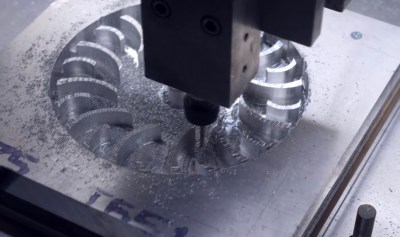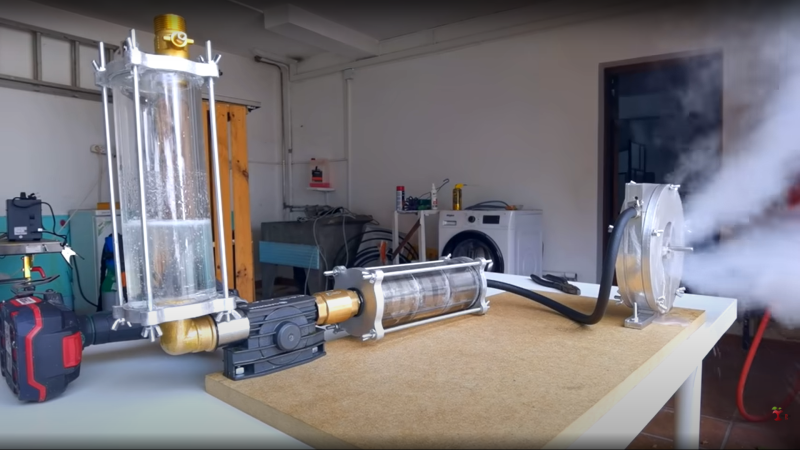[Integza] never fails to amuse with his numerous (and sometimes really sketchy) attempts to create usable thrust, by pretty much all means possible and the latest video (embedded below) attempting to run a reaction turbine from decomposing hydrogen peroxide, doesn’t fail to disappoint. The inspiration came from the WWII V2 rocket, which used Sodium Permanganate to breakdown Hydrogen Peroxide. This produced high pressure steam, which spun a turbine, which in turn drove the turbopumps that delivered the needed huge quantity of alcohol and liquid oxygen into the combustion chamber.
After an initial test of this permanganate-peroxide reaction proved somewhat disappointing (and messy) he moved on to a more controllable approach — using a catalytic converter from a petrol scooter in place of the messy permanganate. This worked, so the next task was to build the turbine. Naturally, this was 3D printed, and the resulting design appeared to work pretty well with compressed air as the power source. After scaling up the design, and shifting to CNC-machined aluminium, it was starting to look a bit more serious. The final test shows the turbine being put through its paces, running from the new precious metal catalyst setup, but as can be seen from the video, there is work to be done.
 There appears to be a fair amount of liquid peroxide passing through into the turbine, which is obviously not desirable. Perhaps the next changes should be the mount the catalyser vertically, to prevent the liquid from leaving so easily, as well as adding some baffling to control the flow of the liquid, in order to force it to recycle inside the reaction vessel? We can’t wait to see where this goes, hopefully the steam-turbine powered skateboard idea could actually be doable? Who knows? But we’re sure [Integza] will find a way!
There appears to be a fair amount of liquid peroxide passing through into the turbine, which is obviously not desirable. Perhaps the next changes should be the mount the catalyser vertically, to prevent the liquid from leaving so easily, as well as adding some baffling to control the flow of the liquid, in order to force it to recycle inside the reaction vessel? We can’t wait to see where this goes, hopefully the steam-turbine powered skateboard idea could actually be doable? Who knows? But we’re sure [Integza] will find a way!
With steam power, there’s more than one way to get usable rotational work, like using a reciprocating engine, which can be expanded to a whole machine shop, and whilst boiling water (or catalytically decomposing Hydrogen Peroxide) provides high pressure gas, how about just using boiling liquid nitrogen? Possibly not.
















While I am not a huge fan of the whole ethos of youtube monetization, I do appreciate that many people still have the ability to learn and own and pass on various skills that would otherwise be lost a generation later. Working knowledge should be passed down, this is especially evident when supply issues show up. EG: we have a serious lack of healthy soil and we have been destroying farmers economically for decades. A sort of birds eye view show to watch is Clarksons’s Farm on Amazon… It gives some good laughs, but the serious difficulty and lack of money in actually producing food becomes very apparent. I appreciate all forms of non-corpratized DIY, even if it is just for laughs or a one off. These types of projects show a whole new generation that anything can be done if you acquire the skills.
This guy does some seriously fun stuff, many of his other videos are worth a look.
>permanganate-catalysed reaction
How many times HaD staffs perpetrate this false info? Permanganate is NOT being to be used a catalyse here. It’s an oxidizing agent.
http://www.titrations.info/permanganate-titration-hydrogen-peroxide
Hydrogen peroxide is usually treated as a strong oxidizer, but in the presence of even stronger oxidizer it can become a reducing agent
H2O2 → O2 + 2H+ + 2e-
2MnO4- + 5H2O2 + 6H+ → 2Mn2+ + 5O2 + 8H2O
Indeed so. Article corrected. My chemistry A-level was a lifetime ago, apologies.
Where does one get 50% hydrogen peroxide?
I wonder if this would be a good power source for a battle bot?
You can boil off the water and concentrate it from whatever lower concentration you have available. Best to boil in under vacuum as too much heat decomposes it.
High test peroxide is very dangerous. I don’t remember if 50% is considered high test or not, but, I’d against trying to get it/concentrate it unless you know exactly what you are doing.
Indeed! I’ve found 34.5%, 30% and 15% for sale on the internet. Probably plenty for my idea. Use a silver catalyst. But run it by the battle bot folks first, and they will likely shoot it down.
Above about 70 percent is where it gets really sketchy but 50 percent is not something to play with if you’re not entirely sure what you’re doing.
You sound like the a$$hole that refused to sell me glycerin, fuming nitric and sulfuric acid when I was in middle school.
I had a plan. A good plan.
Would have gotten me attention from girls in ways that black powder never could.
My dad’s comment (when I went to him, chem prof, to get ‘just a little bit’ of fuming acids): ‘Nitrocellulose is much safer than nitroglycerin, don’t be an idiot.’ He didn’t point me to the reloading section of the gun store though. Left that as an ‘exercise for the student’.
Explosive pyromania is apparently genetic. I’ve seen the marks at the Heidelberg bar he almost burnt down playing with a LOX soaked rope and fire.
Fire is cool!
@HaHa, I hear you man, I hear you. I hope you still have all your digits. I still have all mine, but that was more due to good luck than good technique.
Another YouTube video answers that:
https://www.youtube.com/watch?v=LhEYaovWxl4
“Hydrogen Peroxide: going all the way”
Since half the input liquid is water and the product is water vapor, why is is a surprise that water is coming out?
How does condensed water get out of the turbine? Don’t steam turbines have to run at a pretty high temperature in order to have efficiency and in order to not be sloshing a bunch of water around inside?
Boiler-steam turbines are generally high-pressure steam significantly above boiling temperature (above 600°C in the one paper I skimmed recently). This allows far greater steam pressure, thus greater velocity extration for a turbine.
But steam of any temperature has pressure (can be traded for momentum) energy, and can be used to extract useful work, resulting in loss of heat.
One reason for using supercritical steam is that even after work-extraction, it remains above condensation temperature. For turbines, this avoids cavitation damage; for reciprocating engines, it avoids liquid lockups.
Hydrogen peroxide decomposition cannot generate dry steam; even if there is sufficient heat, the decomposition also pulls along tiny liquid droplets that get entrained in the steam flow, but remain liquid. (This is also true of any boiler without a superheater).
Steam can be fun and accessible, but is surprisingly complicated to scale up, or if high efficiency and low maintenance are needed.
Because a lot of that isn’t water but unreacted peroxide that made it’s way through the catalyst. On top of that with the relatively low reaction rate Integza achieves in his catalyzer staker and the long tube there’s plenty of time for the somewhat cool steam to condense back into water before it gets to the turbine. Turbines of the type built by Integza work just fine with very wet steam but perform much better with hot steam. There’s an upper limit though as they’re not that good at expanding the steam to fully utilize the thermal power in the input steam.
Fun build. Starting to look more reasonable than hist 3D printed plastic rocket engines.
But now I’m wondering about those scooter catalytic converters. Hunh? Don’t you need an ECU, oxygen sensors, and fuel injection to make those work properly? You can make that system small and cheap enough for scooters now? So why don’t the neighborhood Harleys have them?
Why would you need all that? Even if they’re not running at optimal temperature, they still have some effect on exhaust emissions, especially ones perceived as noxious by bystanders.
However, given the space and flow constraints on small scooters (often 50cc), it’s often not possible to engineer an efficient exhaust flow even without a catalystic converter in the way. With a catalytic converter, you often lose most of what little power is available in such a small engine. Up-engining to the point of getting equal power can often result in more tailpipe pollution than the converter saved in the first place.
Many jurisdictions seem to mandate these on small two-stroke scooters. On a two-stroke, the hot catalytic element has even worse of an effect on engine dynamics than it would on a same-size four-stroke, but if everything goes well, it can substantially mitigate the potential for obnoxious gas emissions. In high-population-density scooter-depndent regions, this can make a major difference in traffic-generated smog effects.
If you’re interested in details, one study was “Ceramic Catalytic Converters for Motorcycles and Scooters” by K. P. Reddy, S. K. Duggal and Jose J. Garcia, published in SAE Transactions
Vol. 105, Section 3: JOURNAL OF ENGINES (1996). Any good web search should be able to find at least an abstract, and there are other good studies on the subject.
Don’t you need an ECU, oxygen sensors, and fuel injection to make those work properly?
Yes. You definitely need a 4-stroke engine that’s not burning too much oil or that little catalytic converter matrix will get gummed up in short order. Having an oxygen sensor and an ECU accurately controlling fuel through a fuel injection system definitely helps efficiency but I don’t think they’re a definitive requirement. But to put it simply, especially in Europe, plenty of motor scooters are now running fuel-injected 4-stroke engines and using a catalytic converter with those isn’t much of a problem.
New Harleys are programmed to miss. To reproduce the classic Harley sound. They are fuel injected etc.
Harley tried to copyright the sound of a V-twin, they lost. But they did get a copyright on the sound of a very poorly tuned V-twin that misses, backfires and doesn’t idle.
India can have them.